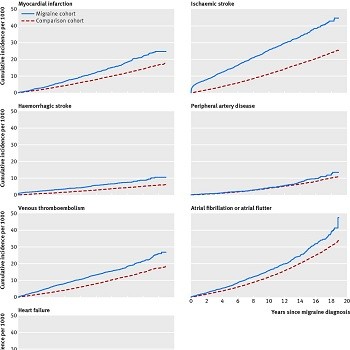Our official English website, www.x-mol.net, welcomes your
feedback! (Note: you will need to create a separate account there.)
Migraine and risk of cardiovascular diseases: Danish population based matched cohort study.
The BMJ ( IF 93.6 ) Pub Date : 2018-01-31 , DOI: 10.1136/bmj.k96 Kasper Adelborg 1 , Szimonetta Komjáthiné Szépligeti 2 , Louise Holland-Bill 2 , Vera Ehrenstein 2 , Erzsébet Horváth-Puhó 2 , Victor W Henderson 2, 3, 4 , Henrik Toft Sørensen 2, 3
The BMJ ( IF 93.6 ) Pub Date : 2018-01-31 , DOI: 10.1136/bmj.k96 Kasper Adelborg 1 , Szimonetta Komjáthiné Szépligeti 2 , Louise Holland-Bill 2 , Vera Ehrenstein 2 , Erzsébet Horváth-Puhó 2 , Victor W Henderson 2, 3, 4 , Henrik Toft Sørensen 2, 3
Affiliation

|
OBJECTIVE
To examine the risks of myocardial infarction, stroke (ischaemic and haemorrhagic), peripheral artery disease, venous thromboembolism, atrial fibrillation or atrial flutter, and heart failure in patients with migraine and in a general population comparison cohort.
DESIGN
Nationwide, population based cohort study.
SETTING
All Danish hospitals and hospital outpatient clinics from 1995 to 2013.
PARTICIPANTS
51 032 patients with migraine and 510 320 people from the general population matched on age, sex, and calendar year.
MAIN OUTCOME MEASURES
Comorbidity adjusted hazard ratios of cardiovascular outcomes based on Cox regression analysis.
RESULTS
Higher absolute risks were observed among patients with incident migraine than in the general population across most outcomes and follow-up periods. After 19 years of follow-up, the cumulative incidences per 1000 people for the migraine cohort compared with the general population were 25 v 17 for myocardial infarction, 45 v 25 for ischaemic stroke, 11 v 6 for haemorrhagic stroke, 13 v 11 for peripheral artery disease, 27 v 18 for venous thromboembolism, 47 v 34 for atrial fibrillation or atrial flutter, and 19 v 18 for heart failure. Correspondingly, migraine was positively associated with myocardial infarction (adjusted hazard ratio 1.49, 95% confidence interval 1.36 to 1.64), ischaemic stroke (2.26, 2.11 to 2.41), and haemorrhagic stroke (1.94, 1.68 to 2.23), as well as venous thromboembolism (1.59, 1.45 to 1.74) and atrial fibrillation or atrial flutter (1.25, 1.16 to 1.36). No meaningful association was found with peripheral artery disease (adjusted hazard ratio 1.12, 0.96 to 1.30) or heart failure (1.04, 0.93 to 1.16). The associations, particularly for stroke outcomes, were stronger during the short term (0-1 years) after diagnosis than the long term (up to 19 years), in patients with aura than in those without aura, and in women than in men. In a subcohort of patients, the associations persisted after additional multivariable adjustment for body mass index and smoking.
CONCLUSIONS
Migraine was associated with increased risks of myocardial infarction, ischaemic stroke, haemorrhagic stroke, venous thromboembolism, and atrial fibrillation or atrial flutter. Migraine may be an important risk factor for most cardiovascular diseases.
中文翻译:

偏头痛和心血管疾病的风险:基于丹麦人群的配对队列研究。
目的探讨偏头痛患者和一般人群比较人群的心肌梗死,中风(缺血性和出血性),外周动脉疾病,静脉血栓栓塞,房颤或心房扑动以及心力衰竭的风险。设计在全国范围内进行的基于人群的队列研究。设置1995年至2013年间所有丹麦医院和医院的门诊诊所。参加者51 032例偏头痛患者和510 320普通人群按年龄,性别和日历年度进行匹配。主要观察指标根据Cox回归分析,合并症调整了心血管疾病的危险比。结果在大多数结局和随访期间,偏头痛事件的绝对风险高于一般人群。经过19年的随访,与一般人群相比,偏头痛组每千人的累积发生率是:心肌梗塞为25 v 17,缺血性中风为45 v 25,出血性中风为11 v 6,外周动脉疾病为13 v 11,静脉为27 v 18血栓栓塞,对于房颤或房扑为47 v 34,对于心力衰竭为19 v 18。相应地,偏头痛与心肌梗死(风险比调整后为1.49,95%置信区间1.36至1.64),缺血性中风(2.26、2.11至2.41)和出血性中风(1.94、1.68至2.23)呈正相关。 (1.59,1.45至1.74)和房颤或房扑(1.25,1.16至1.36)。没有发现与周围动脉疾病(风险比调整后的1.12,0.96至1.30)或心力衰竭(1.04,0.93至1)有意义的关联。16)。有先兆的患者比没有先兆的患者,在诊断后的短期内(0-1年),与长期(长达19年)的关联性要强于长期(至19年),女性的关联性要强于男性。在亚组患者中,在对体重指数和吸烟进行了其他多变量调整后,这种关联仍然存在。结论偏头痛与心肌梗死,缺血性中风,出血性中风,静脉血栓栓塞和房颤或房扑的风险增加有关。偏头痛可能是大多数心血管疾病的重要危险因素。在亚组患者中,在对体重指数和吸烟进行了其他多变量调整后,这种关联仍然存在。结论偏头痛与心肌梗死,缺血性中风,出血性中风,静脉血栓栓塞和房颤或房扑的风险增加有关。偏头痛可能是大多数心血管疾病的重要危险因素。在亚组患者中,在对体重指数和吸烟进行了其他多变量调整后,这种关联仍然存在。结论偏头痛与心肌梗死,缺血性中风,出血性中风,静脉血栓栓塞和房颤或房扑的风险增加有关。偏头痛可能是大多数心血管疾病的重要危险因素。
更新日期:2018-02-01
中文翻译:

偏头痛和心血管疾病的风险:基于丹麦人群的配对队列研究。
目的探讨偏头痛患者和一般人群比较人群的心肌梗死,中风(缺血性和出血性),外周动脉疾病,静脉血栓栓塞,房颤或心房扑动以及心力衰竭的风险。设计在全国范围内进行的基于人群的队列研究。设置1995年至2013年间所有丹麦医院和医院的门诊诊所。参加者51 032例偏头痛患者和510 320普通人群按年龄,性别和日历年度进行匹配。主要观察指标根据Cox回归分析,合并症调整了心血管疾病的危险比。结果在大多数结局和随访期间,偏头痛事件的绝对风险高于一般人群。经过19年的随访,与一般人群相比,偏头痛组每千人的累积发生率是:心肌梗塞为25 v 17,缺血性中风为45 v 25,出血性中风为11 v 6,外周动脉疾病为13 v 11,静脉为27 v 18血栓栓塞,对于房颤或房扑为47 v 34,对于心力衰竭为19 v 18。相应地,偏头痛与心肌梗死(风险比调整后为1.49,95%置信区间1.36至1.64),缺血性中风(2.26、2.11至2.41)和出血性中风(1.94、1.68至2.23)呈正相关。 (1.59,1.45至1.74)和房颤或房扑(1.25,1.16至1.36)。没有发现与周围动脉疾病(风险比调整后的1.12,0.96至1.30)或心力衰竭(1.04,0.93至1)有意义的关联。16)。有先兆的患者比没有先兆的患者,在诊断后的短期内(0-1年),与长期(长达19年)的关联性要强于长期(至19年),女性的关联性要强于男性。在亚组患者中,在对体重指数和吸烟进行了其他多变量调整后,这种关联仍然存在。结论偏头痛与心肌梗死,缺血性中风,出血性中风,静脉血栓栓塞和房颤或房扑的风险增加有关。偏头痛可能是大多数心血管疾病的重要危险因素。在亚组患者中,在对体重指数和吸烟进行了其他多变量调整后,这种关联仍然存在。结论偏头痛与心肌梗死,缺血性中风,出血性中风,静脉血栓栓塞和房颤或房扑的风险增加有关。偏头痛可能是大多数心血管疾病的重要危险因素。在亚组患者中,在对体重指数和吸烟进行了其他多变量调整后,这种关联仍然存在。结论偏头痛与心肌梗死,缺血性中风,出血性中风,静脉血栓栓塞和房颤或房扑的风险增加有关。偏头痛可能是大多数心血管疾病的重要危险因素。











































 京公网安备 11010802027423号
京公网安备 11010802027423号